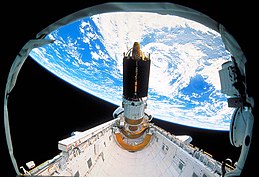TDRS-4
 TDRS-D being deployed from Discovery | |
| Mission type | Communication |
|---|---|
| Operator | NASA |
| COSPAR ID | 1989-021B |
| SATCAT no. | 19883 |
| Mission duration | 10 years (design life) 22 years (actual) |
| Spacecraft properties | |
| Manufacturer | TRW |
| Launch mass | 3,180 kilograms (7,010 lb)[1] |
| Start of mission | |
| Launch date | 13 March 1989, 14:57:00 UTC |
| Rocket | Space Shuttle Discovery STS-29R / IUS |
| Launch site | Kennedy LC-39B |
| End of mission | |
| Disposal | Decommissioned |
| Deactivated | December 2011 |
| Orbital parameters | |
| Reference system | Geocentric |
| Regime | Geostationary |
| Longitude | 41° West (1988-2005) 46° West (2005—2011) |
| Perigee altitude | 35,771 kilometers (22,227 mi) |
| Apogee altitude | 35,805 kilometers (22,248 mi) |
| Inclination | 10.15 degrees |
TDRS-4, known before launch as TDRS-D, is an American communications satellite which was operated by NASA as part of the Tracking and Data Relay Satellite System from 1989 until 2011. It was constructed by TRW, based on a custom satellite bus which was used for all seven of the first generation TDRS satellites.[2]
History

TDRS-D was launched aboard Space Shuttle Discovery during the STS-29R mission in 1989. Discovery launched from Launch Complex 39B at the Kennedy Space Center at 14:57:00 GMT on 13 March 1989.[3] TDRS-D was deployed from Discovery a few hours after launch, and was raised to geostationary orbit by means of an Inertial Upper Stage.[3]
Deployment
The twin-stage solid-propellant Inertial Upper Stage made two burns. The first stage burn occurred shortly after deployment from Discovery, and placed the satellite into a geosynchronous transfer orbit. At 03:30 GMT on 14 March, it reached apogee, and the second stage fired, placing TDRS-D into geosynchronous orbit.[4] At this point it received its operational designation, TDRS-4. It was placed at a longitude 41 degrees west of the Greenwich Meridian,[5][6] from where it provided communications services to spacecraft in Earth orbit, including the Space Shuttle and International Space Station. In 2005, it was relocated to 46° West.[5]
Retirement
TDRS-4 completed its planned mission in November 2011, and was subsequently removed to a disposal orbit 350 kilometres (220 mi) above GEO belt, per International Telecommunications Union (ITU) and United Nations (UN) recommendations, in early December 2011.[7] In May 2012 NASA reported that the orbit-raising manoeuvre had been completed successfully, and the spacecraft had been retired.[8]
References
- ^ "UCS Satellite Database". Union of Concerned Scientists. 2009-07-01. Retrieved 2009-08-09.
- ^ Krebs, Gunter. "TDRS 1, 2, 3, 4, 5, 6". Gunter's Space Page. Retrieved 2009-08-09.
- ^ a b McDowell, Jonathan. "Launch Log". Jonathan's Space Page. Retrieved 2009-08-09.
- ^ McDowell, Jonathan. "Index". Geostationary Orbit Catalog. Jonathan's Space Page. Retrieved 2009-08-09.
- ^ a b "TDRS 4". TSE. Retrieved 2009-08-09.
- ^ "The TDRS-J satellite". Spaceflight Now. 2002-12-01. Retrieved 2009-08-09.
- ^ Johnson, Nicholas (2011-12-05). "Space debris issues". audio file, @1:03:05-1:05:10. The Space Show. Retrieved 2011-12-08.
- ^ "TDRS-4 Mission Complete; Spacecraft Retired From Active Service". NASA. 8 May 2012. Retrieved 11 May 2012.

